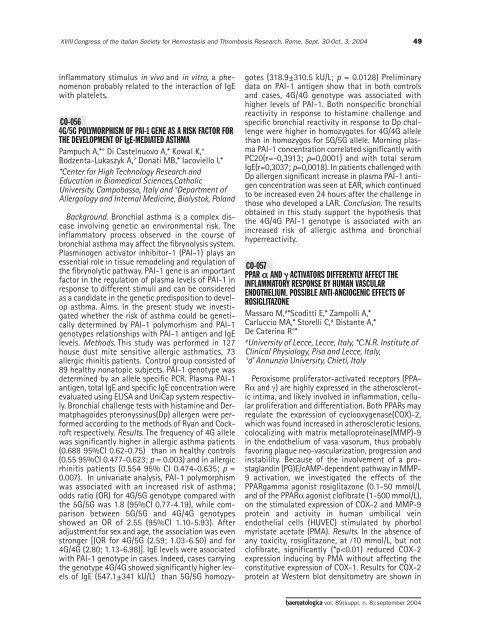Haematologica 2004;89: supplement no. 8 - Supplements ...
Haematologica 2004;89: supplement no. 8 - Supplements ...
Haematologica 2004;89: supplement no. 8 - Supplements ...
- No tags were found...
Create successful ePaper yourself
Turn your PDF publications into a flip-book with our unique Google optimized e-Paper software.
XVIII Congress of the Italian Society for Hemostasis and Thrombosis Research, Rome, Sept. 30-Oct. 3, <strong>2004</strong>49inflammatory stimulus in vivo and in vitro, a phe<strong>no</strong>me<strong>no</strong>nprobably related to the interaction of IgEwith platelets.CO-0564G/5G POLYMORPHISM OF PAI-1 GENE AS A RISK FACTOR FORTHE DEVELOPMENT OF IgE-MEDIATED ASTHMAPampuch A,*° Di Castelnuovo A,* Kowal K,°Bodzenta-Lukaszyk A,° Donati MB,* Iacoviello L**Center for High Tech<strong>no</strong>logy Research andEducation in Biomedical Sciences,CatholicUniversity, Campobasso, Italy and °Department ofAllergology and Internal Medicine, Bialystok, PolandBackground. Bronchial asthma is a complex diseaseinvolving genetic an environmental risk. Theinflammatory process observed in the course ofbronchial asthma may affect the fibry<strong>no</strong>lysis system.Plasmi<strong>no</strong>gen activator inhibitor-1 (PAI-1) plays anessential role in tissue remodeling and regulation ofthe fibry<strong>no</strong>lytic pathway. PAI-1 gene is an importantfactor in the regulation of plasma levels of PAI-1 inresponse to different stimuli and can be consideredas a candidate in the genetic predisposition to developasthma. Aims. In the present study we investigatedwhether the risk of asthma could be geneticallydetermined by PAI-1 polymorhism and PAI-1ge<strong>no</strong>types relationships with PAI-1 antigen and IgElevels. Methods. This study was performed in 127house dust mite sensitive allergic asthmatics, 73allergic rhinitis patients. Control group consisted of<strong>89</strong> healthy <strong>no</strong>natopic subjects. PAI-1 ge<strong>no</strong>type wasdetermined by an allele specific PCR. Plasma PAI-1antigen, total IgE and specific IgE concentration wereevaluated using ELISA and UniCap system respectivly.Bronchial challenge tests with histamine and Dermatphagoidespteronyssinus(Dp) allergen were performedaccording to the methods of Ryan and Cockroftrespectively. Results. The frequency of 4G allelewas significantly higher in allergic asthma patients(0.688 95%CI 0.62-0.75) than in healthy controls(0.55 95%CI 0.477-0.623; p = 0.003) and in allergicrhinitis patients (0.554 95% CI 0.474-0.635; p =0.007). In univariate analysis, PAI-1 polymorphismwas associated with an increased risk of asthma;odds ratio (OR) for 4G/5G ge<strong>no</strong>type compared withthe 5G/5G was 1.8 (95%CI 0.77-4.19), while comparisonbetween 5G/5G and 4G/4G ge<strong>no</strong>typesshowed an OR of 2.55 (95%CI 1.10-5.93). Afteradjustment for sex and age, the association was evenstronger [(OR for 4G/5G (2.59; 1.03-6.50) and for4G/4G (2.80; 1.13-6.98)]. IgE levels were associatedwith PAI-1 ge<strong>no</strong>type in cases. Indeed, cases carryingthe ge<strong>no</strong>type 4G/4G showed significantly higher levelsof IgE (547.1±341 kU/L) than 5G/5G homozygotes(318.9±310.5 kU/L; p = 0.0128) Preliminarydata on PAI-1 antigen show that in both controlsand cases, 4G/4G ge<strong>no</strong>type was associated withhigher levels of PAI-1. Both <strong>no</strong>nspecific bronchialreactivity in response to histamine challenge andspecific bronchial reactivity in response to Dp challengewere higher in homozygotes for 4G/4G allelethan in homozygos for 5G/5G allele. Morning plasmaPAI-1 concentration correlated significantly withPC20(r=-0,3913; p=0,0001) and with total serumIgE(r=0,3037; p=0,0018). In patients challenged withDp allergen significant increase in plasma PAI-1 antigenconcentration was seen at EAR, which continuedto be increased even 24 hours after the challenge inthose who developed a LAR. Conclusion. The resultsobtained in this study support the hypothesis thatthe 4G/4G PAI-1 ge<strong>no</strong>type is associated with anincreased risk of allergic asthma and bronchialhyperreactivity.CO-057PPAR α AND γ ACTIVATORS DIFFERENTLY AFFECT THEINFLAMMATORY RESPONSE BY HUMAN VASCULARENDOTHELIUM. POSSIBLE ANTI-ANGIOGENIC EFFECTS OFROSIGLITAZONEMassaro M, # *Scoditti E,* Zampolli A,*Carluccio MA,* Storelli C, # Distante A,*De Caterina R°*#University of Lecce, Lecce, Italy, *C.N.R. Institute ofClinical Physiology, Pisa and Lecce, Italy,°d’ Annunzio University, Chieti, ItalyPeroxisome proliferator-activated receptors (PPA-Rα and γ) are highly expressed in the atheroscleroticintima, and likely involved in inflammation, cellularproliferation and differentiation. Both PPARs mayregulate the expression of cyclooxygenase(COX)-2,which was found increased in atherosclerotic lesions,colocalizing with matrix metalloproteinase(MMP)-9in the endothelium of vasa vasorum, thus probablyfavoring plaque neo-vascularization, progression andinstability. Because of the involvement of a prostaglandin(PG)E/cAMP-dependent pathway in MMP-9 activation, we investigated the effects of thePPARgamma agonist rosiglitazone (0.1-50 mmol/Land of the PPARα agonist clofibrate (1-500 mmol/L),on the stimulated expression of COX-2 and MMP-9protein and activity in human umbilical veinendothelial cells (HUVEC) stimulated by phorbolmyristate acetate (PMA). Results. In the absence ofany toxicity, rosiglitazone, at ⁄10 mmol/L, but <strong>no</strong>tclofibrate, significantly (*p
















